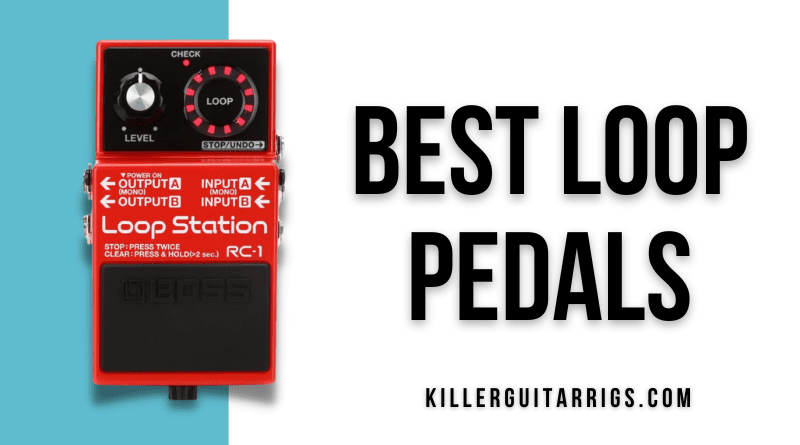Thanks to notable use by some high profile artists, looper pedals have seen a huge resurgence in popularity recently, and by loading a decent looper onto your pedal board, you’ll be able to unlock unique layers within your playing, especially when you combine them with other FX.
For most players, we think that the Boss RC-1 Loop Station is the pedal to go for.
This is one of the most user friendly loopers available today, and thanks to its generous 12 minutes of recording capacity, provides ample looping and sampling for pretty much any practice, studio, or live situation.
It offers an undo/redo function (which we think is nothing short of a lifesaver), allowing for easy mistake correction or the addition of extra layers without losing what you’ve done so far.
In typical Boss fashion, the build quality is bulletproof, and even comes in the standard Boss pedal form factor.
With features like these, it’s no wonder we named the Boss RC-1 Loop Station as our Top Pick.
If you’re looking for maximum features and you’re not limited by price, we think you’ll love the Boss RC-500 Loop Station.
This is a pro grade pedal, but still offers simple operation that even novice loopers will be able to dive right into. Not only does it offer a massive 13 hours of stereo recording, but the quality of the recordings is ultra high fidelity, and won’t degrade with the addition of new layers.
It features built in drum loops, and while we’re on the topic – staying on beat even if you’re not using the drums is made super easy thanks to the color LCD display.
The breadth of features on this pedal make it a great choice for advanced and pro users, while still remaining simple enough for less experienced players.
For these reasons (and more) we gave the Boss RC-500 loop station our Editor’s Choice award.
Should you be looking for something more affordable, the TC Electronic Ditto Looper is well worth trying.
It’s one of the most compact loopers on the market, and because of its single foot switch and solo loop level dial, it’s one of the easiest to use. It’s a no frills looper, but still offers excellent build quality, and really does a great job of keeping up the integrity of your tone.
All loops are recorded in uncompressed 24 bit audio, and you get a respectable 5 minutes of recording capacity. This pedal works with both guitar and bass, and because of the extraordinary value for money it offers, we named it as our Best Budget pick.
Read more about our review process.
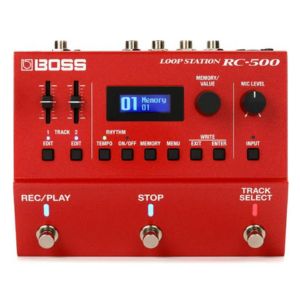
Boss RC-500 Loop Station
Features: 13 Hours stereo record time, 2 Track functionality, Built in drum beats
Benefits: Excellent recording fidelity, Huge looping capacity, Super simple operation
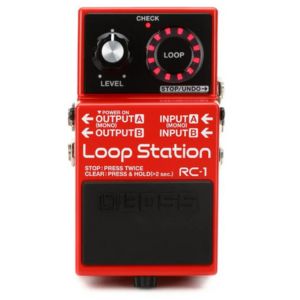
Boss RC-1 Loop Station
Features: Stompbox operation, Stereo in/out, Loop indicator display, 12 Minute recording time
Benefits: Takes up little room, Beginner friendly interface, Built to last
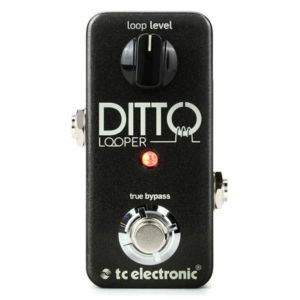
TC Electronic Ditto Looper
Features: Compact design, True bypass circuitry, One knob control
Benefits: Easy operation, Simple USB updates, Leaves tones unprocessed
Contents
Individual Reviews
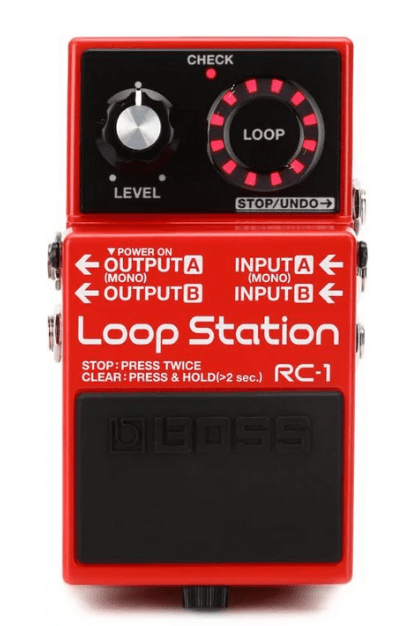
Boss RC-1 Loop Station
The ideal combination of functionality, simplicity, and sturdiness in looping.
One of the most popular loopers, the RC-1 gives you everything you need to loop in the ultimate stompbox form factor, with simplicity and a clear visual guide to everything you do in this pedal. Additionally, you get durability and ease of use, great for professionals and first-time loopers as well.
With 12 minutes of looping and stereo functionality, the Boss RC-1 is a simple yet powerful looper. We jumped right in and started laying down layers and overdubbing. The LED indicator on the main display did a great job of keeping time with each loop, it had great visibility and it was easy to interpret.
When we were recording, it was clearly displayed in the LED indicator in red. While overdubbing, the indicator would turn red/green and then immediately turn green when playing back. We knew exactly what part we were laying down thanks to the color-coded LED indicator, which was a welcome feature.
Recording was as simple as pressing once and starting to play whenever we wanted. When we were done recording a loop, all we had to do was double-press the pedal. And it was simple enough to get rid of loops we didn’t want to keep. Just press and hold to erase.
The RC-1 had retrievable memory, allowing us to save our loops to retrieve later. This would be useful to create interesting textures that could be used at gigs, using previously recorded loops as a starting point.
We used the RC-1 on its default setting, which took us from record to overdub, which was followed by play mode. However, it is possible to switch this order to record, play, and overdub. It was nice that the user gets to choose which order the pedal operates.
This looper came with two stop modes. The first one is the default, where we were able to stop the loop by pressing the pedal during play mode. The other way to stop it is by pressing twice to stop when the phrase ends.
Verdict: Boss is well known as one of the leading companies in guitar pedals, and the Boss RC-1 Loop Station is the most basic model in their lineup. However, don’t be fooled: this looper is capable of a maximum of 12 minutes of recording time and you can run it in stereo. Additionally, just a series of presses and double-presses on the pedal provide complete functionality. In short, a simple and powerful looper from one of the best companies in the game.
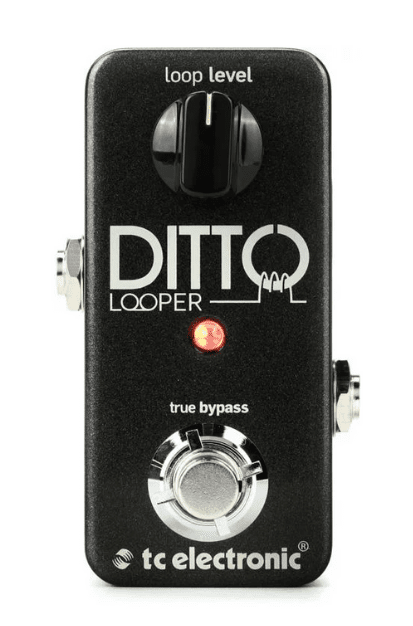
TC Electronic Ditto
Easy to use, small, and budget-friendly, this looper gets the job done.
With just one footswitch and a loop level control, this is the bare-bones budget option to tackle your basic looping needs. Add to that a small form factor, great build quality, and ease of use, and you start to understand why this pedal is so popular among so many musicians.
When it comes to simplicity and small size, the TC Electronic Ditto is second to none. We took it out of the box and were surprised by how small and sturdy it actually is.
As with most TC Electronic products, it was incredibly robust. Thanks to its metal chassis and body, it should hold up well to the rigors of gigging. As a compact pedal, it took up very little room on the pedal board and was easily able to slip into a gig bag.
Despite the TC Electronic Ditto only having one knob and one footswitch (and no buttons), it was surprisingly intuitive. The sound and operation of this simple pedal were both high-quality. We played loop after loop with this pedal’s uncompressed 24-bit audio. The lack of additional features makes it an ideal choice for novices, as there are few features to distract the user.
The TC Electronic Ditto works flawlessly, in a true plug-and-play sort of way. If you are new to looping, the TC Electronic Ditto has one of the simplest designs you’ll find in any pedal, making it a great choice for beginners.
Verdict: The TC Electronic Ditto is a good pedal for a very small price and size. You can use this compact looper for guitar or bass. It features one loop-level knob for dialing in the loop volume, keeping things as simple as possible. It’s true bypass circuitry ensures the integrity of your tone when you’re not using it, and loops are recorded as uncompressed 24-bit audio. In short, you get an essential tool for looping at a low cost with overall good quality.
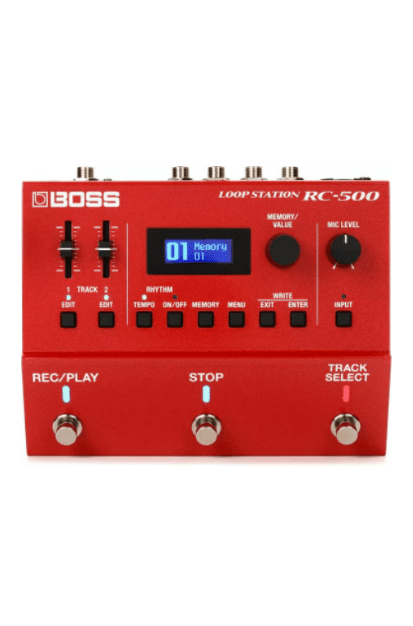
Boss RC-500 Loop Station
A comprehensive tool for the discerning looper.
With MIDI capability, an animated color LCD, versatile onboard drums, and tons of stereo record time, this looping station lets you take your looping to the next stage and then some. Whether you're searching for a spark in creativity for writing songs or developing an act that relies heavily on looping, the Boss RC-500 is one of the best and most comprehensive loopers on the market.
The Boss RC-500 Loop Station builds on the popular Boss RC-30, a 2-track looper. While the older unit had just two footswitches with several knobs on the upper section, the RC-500 adds an extra switch and streamlines the top.
We were impressed by the sturdy and improved design as we fired up the RC-500 Loop Station via its included power source (it can also run on batteries), connected it in stereo, and started looping.
We loved the ergonomics of the footswitches on this pedal, which are angled towards you as you play. This was especially helpful when playing from a seated position.
Although the RC-500 is far more complex than the RC-30, it is also more intuitive to use. For instance, we were able to rely on the animated color LCD screen to always be on top of measure and beat information, as well as record and playback status.
Operating the RC-500 with the three switches was also intuitive. The Rec/Play switch controls the record/play/overdub cycle, while Stop does exactly what it says. For switching back and forth between the two available tracks, we used the Track Select switch. Even though we have experience with other loopers, including the RC-30, it is evident that Boss made ease-of-use one of its priorities for the RC-500.
Another great feature of the RC-500 is its drum loops. It comes with 57 preset rhythm backings, each with two variations and 16 different drum kits to choose from. They can be a great tool to spice up your practice sessions and make them more fun, while keeping you in time.
Verdict: The Boss RC-500 Loop Station is a well-designed and intuitive looper with a fantastic set of features. It gives the user great feedback on what is going on in the unit at all times via its color-coded LCD screen. This pedal offers 13 hours of looping and can take care of all your basic and experimental looping needs.
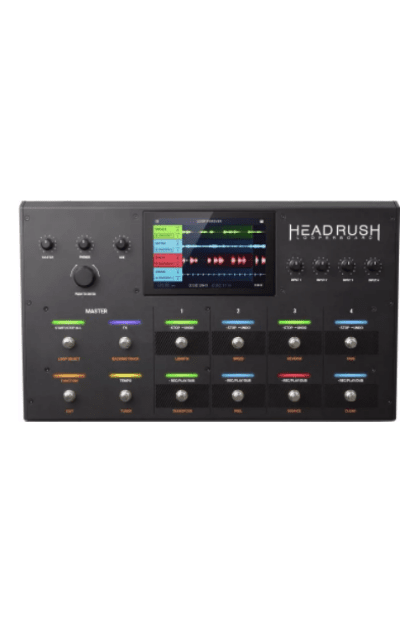
Headrush Looperboard Advanced Performance Looper
The Headrush Looperboard Advanced Performance Looper is the ultimate tool for the consummate looper.
This powerful looper delivers a wide array of features so you can create intricate instrumental and vocal parts, all with excellent quality and flexibility on an intuitive design. It’s a premium unit, but worth the price for those looking for high end performance.
We’ve been looking forward to getting a look at the Headrush Looperboard Advanced Performance Looper for some time. At first glance, it became obvious that this tool is for the dedicated looper who wants to dig deep.
We loved the large and bright 7″ color touchscreen. This screen gave us an easy way to monitor everything while standing, even in unfavorable environments with poor lighting. We even turned off the light in the room to simulate a dark stage and had no problems.
With this screen, we were able to monitor everything we were playing at all times. Besides the fact that we could clearly see what was happening every single moment, it was quite nice to use the touchscreen to swipe and drag as we saw fit. Despite the seemingly endless features on this Headrush looper, it was still user-friendly and simple to use.
It was a pleasure to work with the Looperboard’s quad-core architecture. Combined with its unlimited record time, we were able to build entire song parts without ever wondering when we’d run out of time.
The Looperboard features a tap-tempo switch as well as time-stretching, quantization, and BPM detection.
We used the XLR and 1/4″ outputs to connect to an amp and also to our small PreSonus soundboard going into our interface. Additionally, we were able to record some parts while monitoring via the headphone output.
Verdict: The Headrush Looperboard Advanced Performance Looper is arguably the most powerful and flexible looper available today. With plenty of features and looping options that include multiple instruments and vocals, this looper is for those who like to get deep into looping. Besides offering ease of use, this unit features a premium 32-bit and 48-kHz sample rate that ensures full dynamics and overall quality of your audio.
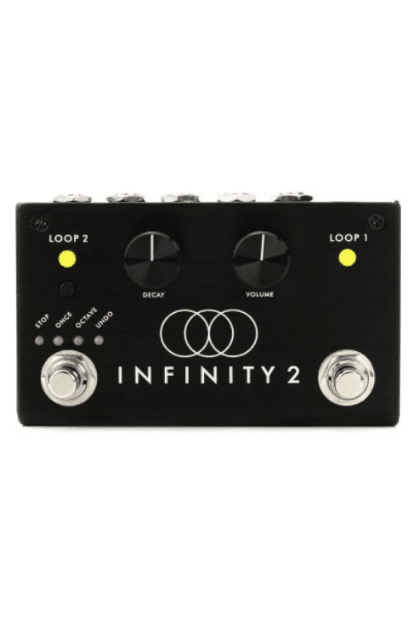
Pigtronix Infinity 2 Looper
An excellent option for those that rely on classic looping but have an itch to experiment every now and then.
Here you get versatility in a looper with ease of use and a slick design that sports just two knobs, two footswitches, and one small button. This loop pedal features a small form factor that allows you not only to cover all of the basic looping needs but also to go off the beaten path and generate new sounds and textures.
The Pigtronix Infinity 2 Looper comes with a respectable number of features for such a little pedal. We especially liked the simplicity and elegance of its design.
The Infinity 2 Looper functions by automatically applying the most-triggered actions to your current loop. In practical terms, we were able to create loops without having to play with spot-on timing. The Infinity 2 would grab whatever part we were trying to superimpose and make it fit on top of the previous part with the correct tempo.
We were also impressed by how easy it was to use this looper. With just a Volume and a Decay knob, the interface was incredibly user-friendly. With the Volume control, we would set the level for our loop, then we’d use the Decay knob to have further control of our audio while overdubbing.
When we set the Decay knob all the way clockwise, this pedal functioned like a regular looper. We created layers recorded at max volume while creating stacks of ideas on a standard operation.
We turned the Decay knob counter-clockwise, to have each of our overdubs disappear following one loop cycle. This allowed us to try out some more experimental ideas without worrying so much about ruining previously recorded loops.
Verdict: The Pigtronix Infinity 2 Looper offers a great blend of cost and features. All of this with great quality and a small-form factor that many guitarists with overcrowded pedalboards will appreciate. On top of that, this looper is very easy to use because of its streamlined design that features just two knobs, two footswitches, and a diminutive button you can press when it’s time to get freaky on your looping.
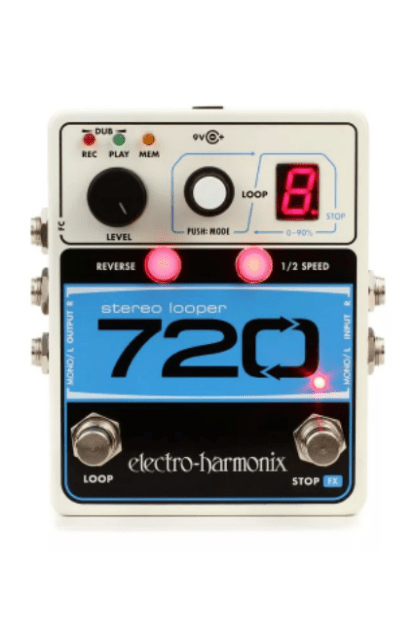
Electro-Harmonix 720 Stereo Looper
Signature EHX quality, durability, and spunk on a looper for the road.
With this EHX looper, you get a lot of bang for the buck. With unlimited overdubbing, the ability to loop two instruments at once, high-quality sound, and other features, this pedal offers a great looping experience.
No list of the best pedals would be complete without including an Electro-Harmonix. Their solid quality and renowned durability have been recognized for decades and were evident here as soon as we took the Electro-Harmonix 720 Stereo Looper out of the box.
It’s a sturdy and well-designed looper that features up to 12 minutes of uncompressed audio, at 24-bit and a sample rate of 44.1 kHz.
We plugged into two separate amps to take advantage of this looper’s stereo capability and started laying down some loops.
We started playing and used all of the available storage of 10 individual loops. These can be retrieved through the Loop knob, which is great for developing ideas or showing up to the gig with some pre-recorded loops. These saved loops can also be accessed via an additional 3-button footswitch (not included).
With its unlimited overdubbing, we then engaged the reverse as well as the 1/2 time buttons and found ourselves in a sort of psychedelic experimental ground that brought out some unique ideas.
With the two footswitches, we controlled the basic loop functions, including recording, overdubbing, undo, and redo. We also used the Loop button to access the three modes available and to cycle through the 10 loop banks we previously stored.
The only drawback to this EHX looper is that it does not feature USB connectivity, which is found on many other offerings.
Verdict: The Electro Harmonix 720 Stereo Looper is yet more proof of the brand’s solid reputation. You can store 10 independent loops with up to 12 minutes of performance and with unlimited overdubbing. This simple two-footswitch design is easy to use and as durable as it gets. Add to that stereo operation, 1/2 speed, and reverse features and you have a looper that will last you for years.
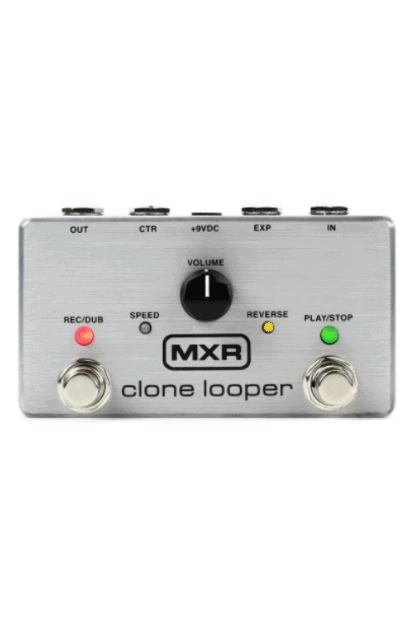
MXR Clone Looper
Fantastic sound quality and great looping capabilities as well as durability in a sturdy looper.
With a high-fidelity sample rate of 88.2 kHz, a maximum of 6 minutes with unlimited layers of looping, stretchable time through an expression pedal (or even a tempo-tap switch), and a durable brushed metal housing, this pedal was built for the toughest gig conditions and great sound.
The MXR Clone Looper excels in sound quality, ease of use, and build quality. We wanted to test the stated sound quality with sample rates that go all the way to 88.2 kHz by plugging in and dialing in some distortion from the get-go. The sound quality was stellar, as we looped harmonized distorted lines on top of some power chords.
It was easy to get carried away laying riffs on top of more riffs, enjoying the simplicity of this pedal. The Clone Looper features a streamlined design with only two foot switches and one volume knob, so it’s quite easy to use, especially if you have previous experience with a looper.
It can handle a maximum of six minutes of looping as well as unlimited overdubs, and the loops we recorded remained in the pedal once we powered it down.
The Clone Looper features a flashing 4-count entrance at the loop’s start, which was very handy. This allowed us to create even more intricate parts, as there was never a doubt about when it was time to begin recording the next layer.
Then, using the MXR Clone Lopper’s 1/2–2x time-stretching feature, we created some textures that were unique and took our creativity to the next level.
Besides the versatility, ease of use, and fantastic sound quality, the Clone Looper is housed in a practically-indestructible brushed-metal chassis.
Verdict: The MXR Clone Looper is a versatile looper with a slick design and superior sound quality. With features like togglable true/buffered bypass switching, 88.2 kHz sample rate, analog through-path, and a very durable brushed-metal housing, this looper is a good choice for the gigging musician.
How to Choose The Right Pedal for You
Looping has become increasingly popular in the last two decades. There are many well-known artists who have brought loopers into visibility, leading to increased demand from a variety of musicians. For instance, superstar Ed Sheeran based much of his act on a looper, and master jazz guitarist John Scofield just released a solo album with every track featuring a looper.
However, there are significant differences in looper pedals. The crucial issue is understanding what you need the pedal for. For instance, a songwriter is going to have different looping needs than an experimental jazz guitarist.
Think of a looper as an instrument, much like a guitar itself. A classical guitar is unlikely to be the best choice for a metal guitarist, just like a high-output seven-string electric won’t be of much use to a folk songwriter.
Below, we have listed some of the points to take into consideration when choosing.
Ease of Use
Do you want a simple pedal that is easy to operate and offers basic looping? Or does your music demand an advanced pedal with many features and endless possibilities? What exactly are you looking to do with the looper and do you mind if it’s a bit more complex to operate?
Price
What is your budget? How much are you willing to spend? Do you want to pay for all those extra knobs, extended I/O and fancy screens?
Flexibility
Do you need to create numerous loops, switch between them on the fly, or use MIDI sync to match your looper with other time-based pedals? Do you need your looper to connect in stereo? What about that drum-machine section with over 100 rhythms, do you need that?
Size
Are you willing to go for a bigger pedal in order to have more features? Do you mind having half a dozen footswitches or do you prefer something leaner? How much weight are you willing to haul to every gig? Can you easily and conveniently store a big pedal in your backpack, studio, etc?
Where Will You Use It?
Do you plan on using your looper for live performances? Is it easy to operate standing up while you are playing? Is it sufficiently hands-free? Or, do you need it at your home studio, in order to develop ideas and have a creative tool?
Build Quality
Is quality the most important factor in your decision to buy a looper? Are you willing to take on the price and size that often comes with higher quality? How durable do you want the pedal to be, including the chassis and inside components?
Like most things gear-related, the best loop pedal for you is a largely personal choice. However, it is wise to exercise caution if you are just starting out. If you have little experience with loopers, you may not want to overboard on the price and features. Then again, if you love a challenge and welcome steep learning curves, perhaps a fancier and pricey looper is just what you need.
Final Thoughts
Looping offers a unique way to build on a performance by recording several parts and stacking them, or an easy way to practice playing different sections without the assistance of a band. Additionally, you can also discover unique sounds and textures through the special features that some of these loopers have. To summarize, here is a brief recap of our top choices.
If you’re looking for a combination of affordability and quality, the Boss RC-1 Loop Station is an excellent choice and our Top Pick. If on the other hand, you’re trying to spend a bit less money, check out our Best Budget choice, the TC-Electronic Ditto. Finally, if you demand the best and do not have budget limitations, then check out our Editor’s Choice, the Boss RC-500 Loop Station.

